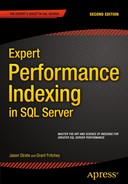Contents
Index Data Definition Language
![]() Chapter 2: Index Storage Fundamentals
Chapter 2: Index Storage Fundamentals
Shared Global Allocation Map Page
sys.dm_db_database_page_allocations
![]() Chapter 3: Index Metadata and Statistics
Chapter 3: Index Metadata and Statistics
Index-Level Statistics Summary
Index Operational Stats Summary
Supporting Methods with Indexes
Understanding Statistics, Properties, and Information
Restrictions on Spatial Indexes
Full-Text Search Index Catalog Views and Properties
![]() Chapter 7: Indexing Memory-Optimized Tables
Chapter 7: Indexing Memory-Optimized Tables
Memory-Optimized Tables Overview
![]() Chapter 8: Indexing Myths and Best Practices
Chapter 8: Indexing Myths and Best Practices
Myth 1: Databases Don’t Need Indexes
Myth 2: Primary Keys Are Always Clustered
Myth 3: Online Index Operations Don’t Block
Myth 4: Any Column Can Be Filtered in Multicolumn Indexes
Myth 5: Clustered Indexes Store Records in Physical Order
Myth 6: Indexes Always Output in the Same Order
Myth 7: Fill Factor Is Applied to Indexes During Inserts
Myth 8: Deleting Form Heaps Results in Unrecoverable Space
Myth 9: Every Table Should Have a Heap/Clustered Index
Use Clustered Indexes on Primary Keys by Default
Automatically Maintaining Statistics
Manually Maintaining Statistics
Database Engine Tuning Advisor
![]() Chapter 11: Indexing Strategies
Chapter 11: Indexing Strategies
![]() Chapter 13: Monitoring Indexes
Chapter 13: Monitoring Indexes
Database Engine Tuning Advisor
